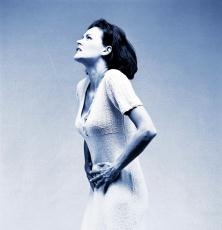
1) The Numbers
Ovarian cancer is a relatively rare, but deadly, cancer. The National Cancer Institute estimates 22,280 women will be diagnosed with ovarian cancer this year, and 15,500 women will die of the disease. (For comparison, the NCI estimates that 226,870 women will be diagnosed with breast cancer, and 39,510 women will die of that disease this year.)
Ovarian cancer is more often diagnosed in white women than in women of other races. In the U.S., there are 13.4 cases diagnosed yearly for every 100,000 white women, 11.3 cases per 100,000 Hispanic women, and 9.8 cases per 100,000 black or Asian women.
The overall 5-year survival rate for ovarian cancer is 43.7 percent, but the survival rate varies greatly with the stage at which a woman is diagnosed. According to the NCI, 91.5 percent of patients diagnosed before the cancer has spread survive at least five years, whereas only 26.9 percent of those diagnosed after the cancer has spread to other sites in the body survive five years.
2) Signs and symptoms
Signs and symptoms of ovarian cancer may include:
- Abdominal pressure, fullness, swelling or bloating
- Pelvic discomfort or pain
- Persistent indigestion, gas or nausea
- Changes in bowel habits, such as constipation
- Changes in bladder habits, including a frequent need to urinate
- Loss of appetite or quickly feeling full
- A persistent lack of energy
- Low back pain
3) Screening tests

4) Risk factors for ovarian cancer
A risk factor is anything that changes your chance of getting a disease like cancer. 
But risk factors don’t tell us everything. Having a risk factor, or even several risk factors, does not mean that you will get the disease. And many people who get the disease may not have had any known risk factors. Even if a person with ovarian cancer has a risk factor, it is very hard to know how much that risk factor may have contributed to the cancer. Researchers have discovered several specific factors that change a woman’s likelihood of developing epithelial ovarian cancer. These risk factors don’t apply to other less common types of ovarian cancer like germ cell tumors and stromal tumors.
5) Ovulation and ovarian cancer
A woman’s risk of ovarian cancer seems to increase with the number of times over her life that she ovulates. During ovulation, an egg is released from an ovary 
These findings explain the long-held observation that anything that lowers the number of times a woman ovulates also lowers her ovarian cancer risk. Pregnancy, breast-feeding and birth control pills all temporarily halt ovulation, and studies have linked all of those factors to a decreased risk of ovarian cancer.
To know more about Ovarian Cancer Treatment in India please visit this link : https://safemedtrip.com/medical-services/cancer-treatment-in-india/ovarian-cancer-treatment-in-india.html

 Click to WhatsApp
Click to WhatsApp +91-9899993637
+91-9899993637




